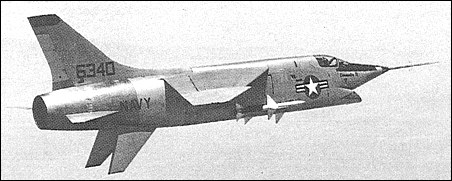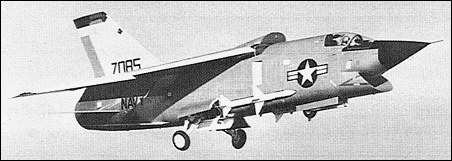|
| Despite its designation of F8U-3, the V-401, first flown on 2 June 1958, was a totally new fighter developed in competition with the McDonnell F4H-1 Phantom II. Vought received contracts for 18 F8U-3s, although, in the event, only five were actually built and two of these remained unflown when cancellation of contracts terminated further work. Known to the manufacturer as the Crusader III, the F8U-3 retained some of the features of the original F8U, such as the variable wing incidence, but was a substantially larger, heavier and more powerful single-seat fighter. The F8U-3 was powered by a Pratt & Whitney J75-P-5A engine affording 7484kgp boosted to 13381kgp with afterburning. Provision was made for a 2722kgp Rocketdyne auxiliary rocket motor in the rear fuselage, and the all-missile armament consisted of three beam-riding Sparrow III AAMs. The F8U-3 had a forward-raked, variable-position, chin-type air intake, and a pair of large ventral fins was linked to the undercarriage retraction mechanism, being raised to the horizontal position when the wheels were extended and adopting a near-vertical attitude when the wheels were retracted. The F8U-3 attained 2832km/h, or Mach=2.6, during flight test, but Vought believed that it was capable of Mach=2.9. With selection of the F4H-1 as the US Navy's next generation shipboard fighter, the F8U-3 was cancelled, the three examples flown having accumulated a total of 190 flight tests.
| MODEL | F8U-3 |
| WEIGHTS |
| Take-off weight | 17587 kg | 38773 lb |
| Empty weight | 9917 kg | 21863 lb |
| DIMENSIONS |
| Wingspan | 12.16 m | 40 ft 11 in |
| Length | 17.88 m | 59 ft 8 in |
| Height | 4.98 m | 16 ft 4 in |
| Wing area | 41.80 m2 | 449.93 sq ft |
| PERFORMANCE |
| Max. speed | 2345 km/h | 1457 mph |
| Range | 3289 km | 2044 miles |
 | A three-view drawing (1680 x 1193) |
| Dan Brouse, e-mail, 17.02.2017 08:09 Joe Angleone was the Vought test pilot on the first flying F8U-3 at Muroc when the ventral fins would not come up. He was told by the company engineers to punch out of the aircraft. Not wanting to lose what was then the only flying test A /C he took it out over the desert and ground off the fins and saved the A /C. reply | | John Nichols, e-mail, 20.05.2015 17:44 Rich Gritter! Are you still out there? Get back to me at j.m.nichols@lmco.com Would like to know the latest with you and Ed MacDonough. reply | | Rich Gritter, e-mail, 29.08.2013 15:11 To all - The chief engineer on the Vought F8U-3 project is still alive and well. His name is Ed MacDonough and he is now approaching 98 years young. His mind is still sharper than two people half his age. I asked him yesterday if he would be willing to answer and questions that folks might have about the airplane design. He is more than willing and can be reached at: edmacd@peoplepc.com
Men like Ed are hard to find and we need to download his brain before he reaches 100. reply | | kenneth hughes, e-mail, 27.08.2013 13:59 what happened to the 5 f8u3 reply | |
| | Jeff Head, e-mail, 28.05.2013 20:10 I know that Crusader IIIs used by NASA embarassed several F-4 Phantom pilots in mach combat to the point that the Navy got NASA to order them to cut it out. reply | | Nels tanner, e-mail, 08.03.2012 14:33 I can not add to other comments on the F8u 3. I also watched it fly out of Moffett field. I have a question for Dave Winiker re; VF 154 and the F8U 1
was this a negative experience? i'm a VF154 F8 /F4 type with a tour in Vf124. just curious. reply | | Steve, e-mail, 26.08.2011 18:28 Sometimes, the Navy's penchant for ordering two competing prototypes for a requirement paid off with an embarassment of riches. The perceived importance of the fleet air defence mission favored the F4H Phantom - but if it had been foretold that within a few years maneuvering combat at visual range would be critically important, the F8U-3 ought to have been the choice. Replacing the two side-mounted Sparrows with four Sidewinders and the centerline Sparrow with a gun would have produced a formidable air-superiority fighter. (Although if the interconnection between the undercarriage and the ventral fins failed in service, there might have been a few embarassing tales for Grampaw Pettibone to relate!) reply | | Don, e-mail, 13.08.2011 02:43 Are any of the F8U 3's in a museum? reply | | RogerB34, e-mail, 04.04.2011 00:43 I recall engaging the AMES F8U3 over San Francisco Bay 1960 in an F8U-1. Bad mistake. reply | | Don Mallick, e-mail, 17.02.2011 01:39 Fellow pilot, William Alford and I flew a sonic boom program at NASA Langley in 1959. The F8U-3 was available to us, after the F4H won the Navy selection. The F8U-3 was a tremendous performer and provided sonic booms from various altitudes and speeds. Our test base line was set at Mach-2 at various altitudes. The early J-75s could not be modulated in after burner. It was full on or off. I had to use speedbrakes to hold it to Mach 2.0--going through the test gate of altitude and Mach number. The windscreen
was not the normal armour plated window, it was a plastic
canopy. After 10 minutes at Mach 2+, the heating could weaken the canopy. We used a five minute limit for a safety factor. Everything about the airplane was performance + for those days. The only complaint that I had about the airplane was on landing roll, in a cross wind. The side plate area was large and the gear narrow. It
tended to lean away from the wind. On top of this, there was no anti-skid on the aircraft. So slowing to a stop in
a crosswind took patience.
I really loved flying the airplane, it was the most high performing aircraft that I had flown to date, and every flight was an experience. We used the a Navy full pressure suit for the missions.
Don Mallick reply | | Mike Garcia, e-mail, 31.01.2009 23:57 The F8U-3 may have lived on. I hired as an enginner at LTV summer of 1962, worked on the last of the F8U-2's and then the A-7A. I was in the Wing Section and told that LTV saved time and money by using the F8U-3 rudder actuator for the A7A Aileron actuator with a slight change in hydraulic port locations. I was told that Vought was working on an improved windshield and frame to withstand the higher heat before the contract was terminated, so we will never know if the 2.9 Mach was feasible. I think it would have been. reply | | Nick Nickerson, e-mail, 12.07.2008 20:56 I was a FRP in VF-124 in 1959 when they brought one to Moffet for us to admire. It was an awesome looking machine. reply | | Dave Winiker, e-mail, 12.07.2008 20:25 In response to Terry Nelson's comment below, the Navy had concluded that it should have a 2 engine, 2 place fighter and opted to buy the F-4 instead. (Perhaps it was due to our squadron's (VF-154) experience with the F-8U-1.) reply | | Terry Nelson AO3 USN, e-mail, 14.07.2007 00:29 Saw two at Alameda NAS in 1959 and was impressed. We airdales could not understand why the Navy chose the F4 over such a fast aircraft as this. It flew a lot faster than the listed speed, so fast that the canopy would change due to heat friction. That from a pilot. reply |
|
Do you have any comments?
|
| 
COMPANY
PROFILE
All the World's Rotorcraft
|









ĶČģń║¦ÕŹüÕŁŚÕåøµłśÕŻ½Õ░Įń«ĪÕĖģ’╝īõĮåµś»Ķ┐śµś»µ»"õĖŹĶ┐ćF4ķ¼╝µĆ¬
reply